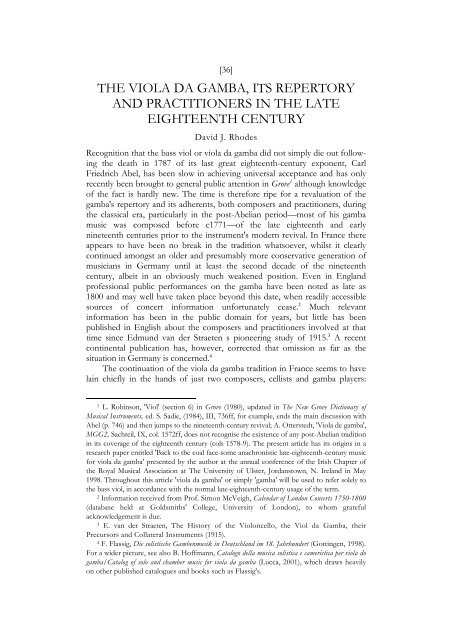download.pdf - 1.2Mb - Viola da Gamba Society
download.pdf - 1.2Mb - Viola da Gamba Society
download.pdf - 1.2Mb - Viola da Gamba Society
Create successful ePaper yourself
Turn your PDF publications into a flip-book with our unique Google optimized e-Paper software.
[36]<br />
THE VIOLA DA GAMBA, ITS REPERTORY<br />
AND PRACTITIONERS IN THE LATE<br />
EIGHTEENTH CENTURY<br />
David J. Rhodes<br />
Recognition that the bass viol or viola <strong>da</strong> gamba did not simply die out following<br />
the death in 1787 of its last great eighteenth-century exponent, Carl<br />
Friedrich Abel, has been slow in achieving universal acceptance and has only<br />
recently been brought to general public attention in Grove 1 although knowledge<br />
of the fact is hardly new. The time is therefore ripe for a revaluation of the<br />
gamba's repertory and its adherents, both composers and practitioners, during<br />
the classical era, particularly in the post-Abelian period—most of his gamba<br />
music was composed before c1771—of the late eighteenth and early<br />
nineteenth centuries prior to the instrument's modern revival. In France there<br />
appears to have been no break in the tradition whatsoever, whilst it clearly<br />
continued amongst an older and presumably more conservative generation of<br />
musicians in Germany until at least the second decade of the nineteenth<br />
century, albeit in an obviously much weakened position. Even in England<br />
professional public performances on the gamba have been noted as late as<br />
1800 and may well have taken place beyond this <strong>da</strong>te, when readily accessible<br />
sources of concert information unfortunately cease. 2 Much relevant<br />
information has been in the public domain for years, but little has been<br />
published in English about the composers and practitioners involved at that<br />
time since Edmund van der Straeten s pioneering study of 1915. 3 A recent<br />
continental publication has, however, corrected that omission as far as the<br />
situation in Germany is concerned. 4<br />
The continuation of the viola <strong>da</strong> gamba tradition in France seems to have<br />
lain chiefly in the hands of just two composers, cellists and gamba players:<br />
1 L. Robinson, 'Viol' (section 6) in Grove (1980), up<strong>da</strong>ted in The New Grove Dictionary of<br />
Musical Instruments, ed. S. Sadie, (1984), III, 736ff, for example, ends the main discussion with<br />
Abel (p. 746) and then jumps to the nineteenth-century revival; A. Otterstedt, '<strong>Viola</strong> de gamba',<br />
MGG2, Sachteil, IX, col. 1572ff, does not recognise the existence of any post-Abelian tradition<br />
in its coverage of the eighteenth century (cols 1578-9). The present article has its origins in a<br />
research paper entitled 'Back to the coal face-some anachronistic late-eighteenth-century music<br />
for viola <strong>da</strong> gamba' presented by the author at the annual conference of the Irish Chapter of<br />
the Royal Musical Association at The University of Ulster, Jor<strong>da</strong>nstown, N. Ireland in May<br />
1998. Throughout this article 'viola <strong>da</strong> gamba' or simply 'gamba' will be used to refer solely to<br />
the bass viol, in accor<strong>da</strong>nce with the normal late-eighteenth-century usage of the term.<br />
2 Information received from Prof. Simon McVeigh, Calen<strong>da</strong>r of London Concerts 1750-1800<br />
(<strong>da</strong>tabase held at Goldsmiths' College, University of London), to whom grateful<br />
acknowledgement is due.<br />
3 E. van der Straeten, The History of the Violoncello, the Viol <strong>da</strong> <strong>Gamba</strong>, their<br />
Precursors and Collateral Instruments (1915).<br />
4 F. Flassig, Die solistische Gambenmusik in Deutschland im 18. Jahrhundert (Gottingen, 1998).<br />
For a wider picture, see also B. Hoffmann, Catalogo della musica solistica e cameristica per viola do<br />
gamba/Catalog of solo and chamber music for viola <strong>da</strong> gamba (Lucca, 2001), which draws heavily<br />
on other published catalogues and books such as Flassig's.
















